
Arthroplasty
Incidence of malalignment not reduced with PSCG vs. conventional instrumentation in TKA
Bone Joint J. 2015 Jan;97-B(1):56-63140 patients scheduled for total knee arthroplasty were randomized to have the procedure completed using either patient specific instrumentation or conventional intramedullary instrumentation. The purpose of this study was to compare radiological, clinical, and perioperative data between groups. The primary outcome was the incidence of outliers in mechanical axis alignment, with >3degrees deviation from neutral alignment considered an outlier. In addition, coronal and sagittal component alignment (with >3deg deviation from preoperative planned alignment considered an outlier), operative data (blood loss, operative time, length of stay), and clinical outcome were assessed. Results demonstrated no significant differences between groups for any of the assessed outcomes.
Unlock the full article
Get unlimited access to OrthoEvidence with a free trial
Start TrialCritical appraisals of the latest, high-impact randomized controlled trials and systematic reviews in orthopaedics
Access to OrthoEvidence podcast content, including collaborations with the Journal of Bone and Joint Surgery, interviews with internationally recognized surgeons, and roundtable discussions on orthopaedic news and topics
Subscription to The Pulse, a twice-weekly evidence-based newsletter designed to help you make better clinical decisions
Exclusive access to original content articles, including in-house systematic reviews, and articles on health research methods and hot orthopaedic topics
Or continue reading this full article
Register Now

Subscribe to "The Pulse"
Evidence-Based Orthopaedics direct to your inbox.




































